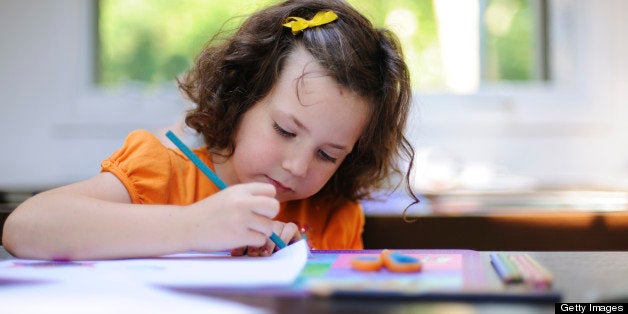
Children directly impacted by a natural disaster certainly suffer emotionally, but with widespread media coverage and talk in school, even those far away from incidents of trauma are increasingly affected. Simple but psychologically sound techniques can help youngsters everywhere cope:
1)Use creative arts to cross over from crisis to comfort. Drawing their experience is the gold standard in counseling kids who experience trauma. It helps them process feelings difficult to express verbally. But in my years of working with children after natural disasters like earthquakes in Haiti, China or Japan, or incidences of violence or terrorism like 9/11 or Newtown, just drawing the traumatic event leaves the child in negativity; instead, I ask them to draw the traumatic event on the left side of a page, then draw a happy experience on the right side, and then draw a bridge between the two -- thus transitioning from the trauma to a happier, healthier state.
2)Make music. Harness the well-known power of music to heal by making up new lyrics to a familiar song. Start with the experience and then bridge to a happier state by adding words about successes and happier encounters, like winning a spelling bee, riding a new bike or acing an exam. Using the popular hip-hop style works well, since rap is based on describing personal experiences. Friends can do this together to spur confidence coming up with words. Drumming is also a good way to release energy, especially for less verbal kids.
3)Share a feeling with a friend. To avoid the all-too-common and depressing belief that you're the only one in suffering -- even when an entire community is affected -- telling a trusted friend about a scary thought or emotion is helpful, especially since kids are often inhibited to talk to their parents.
4)Tap into technology. Search the Internet for facts and sites about coping. Since bad news blares on Internet headlines as kids turn on their computer and hand-held devices, encourage them instead to enter "coping" into search engines. This behavior sets a precedent for using technology for information about good health. Then spread the links with tweets and Facebook posts.
5)Role-play. Practicing actions to take in case of a disaster -- like actually going to a safe place (e.g., a basement) or dialing a contact person -- is more effective preparation than just thinking or talking about what to do, because it conditions muscle memory to be more automatic in an emergency. Do this with a buddy to make it more appealing.
6)Get physical. As I talked about with Alicia Menendez on a HuffPost Live segment about coping in the aftermath of the Oklahoma tornado, the body holds trauma, as we clench our teeth and tense muscles when stressed. Holding this tension in the body can result in physical and mental problems. Release is crucial. Soak in a bubble bath to relax or get active, moving your body, dancing, riding a bike or hitting baseballs.
7)Make gifts for peer survivors. Caring for others makes you feel not alone in suffering. Also, showing support boosts self-esteem. After 9/11 and Newtown, many teddy bears bearing personal notes were placed at disaster site memorials. In my Global Kids Connect Project described in my book, "Living in an Environmentally Traumatized World, Healing Ourselves and our Planet," kids affected by the 3/11 Japan tragedy made cranes with messages of hope to send to kids suffering in Haiti. In my recent workshops with kids in Tanzania -- living in poverty which is another form of disaster -- the youngsters drew birds with greetings for kids in Haiti and Japan, creating a supportive circle of caring around the world.
Teachers and parents should encourage kids to use these approaches, making the process fun as well as meaningful. Embedding the techniques in class curricula or after-school activities is ideal. When kids learn with and from each other, they can come up with constructive actions to make healing and rebuilding widespread and long-lasting.